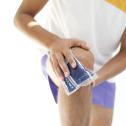So you think you have ITBand Syndrome, now what? If you are still in the acute stage (typically within the first 48 hours), or if it is still chronically inflamed, it’s time to take a break. While it can be very difficult to take a break from your sports or activities of enjoyment, in the long run it will be much better. Working out while your ITBand is still injured can cause the injury to worsen and also cause secondary injuries and increased pain. During the acute phase, be sure to use cold hydrotherapy to decrease inflammation. If you’ve never had to ice an injury before, follow the steps at this link.

What Treatment With Massage Will Entail
If you see a therapist within the first 48 hours of your injury, the massage treatment will be very light over the injury and focused on reducing the inflammation. Secondary muscles that pull on the ITBand, such as the hip flexors and extensors, will be worked on to help reduce the tension within the fascial strip. Prior to leaving your massage session, your therapist may KinesioTape your injury to either reduce swelling or take pressure off of the ITB.
Following the acute stage of the injury, the massage treatment will change. At times the new treatment technique may become tender or painful. It is crucial during your sessions that you properly communicate with your therapist and have them work within your tolerance levels. On a scale of 0-10, with 10 being the worst pain felt in your life, treatments should not exceed a 6. If they start to go past a 6, be sure to notify your therapist so that they are able to reduce pressure.
Depending upon the therapist’s background, they may chose from a few different forms of treatment. Hands on manual therapy will focus on releasing trigger points (or knots) within the muscles associated with the condition as well as working out adhesions along the ITBand itself.
Another technique which may be applied is MyoFascial Release (MFR). This technique can feel “burny” at times and works to allow the fascia to move properly again. When the ITB becomes adhered, it can also cause restrictions in the skin, which then restricts other areas of the body. MFR works to allow the skin and underlying tissues to glide across each other with proper form and function.
A third option for treatment is moving Chinese cupping therapy.

Cupping therapy works as the inverse of hands on massage. While massage therapy pushes in on tissues to work out restrictions, cupping pulls the tissues outwards, helping to release the ITBand from the underlying quads, as well as releasing the skin above the ITBand. Cupping can at times leave marks along the skin that are slightly purple in color. These marks can last for several days on the skin, but the results of how well cupping works are, in my opinion, worth the temporary discoloration.
At the end of the massage, the therapist may choose to use contrast hydrotherapy to help increase positive circulation while getting rid of the excess intracellular debris. To maximize results, it may be necessary to see the therapist once to twice a week until you regain proper range of motion without pain.
Next Posting: ITBand Syndrome Part 3: At Home Care For ITBS
Corinne D. Bracko, CMT, LMT, CKTP has been practicing clinical massage therapy since 2004. She currently owns Dochas Clinical Massage Therapy and works out of her office in Columbia, Missouri. When not working as a therapist, she trains in both long distance running and two forms of martial arts: Songahm Taekwondo and Krav Maga. It is her goal to have massage become a staple of people’s health care plan to encourage a method of illness prevention and non-surgical solutions.
Please feel free to send any questions you may have to CDBracko.LCMT@gmail.com
One thought on “ITBand Syndrome Part 2: Treating with Massage”